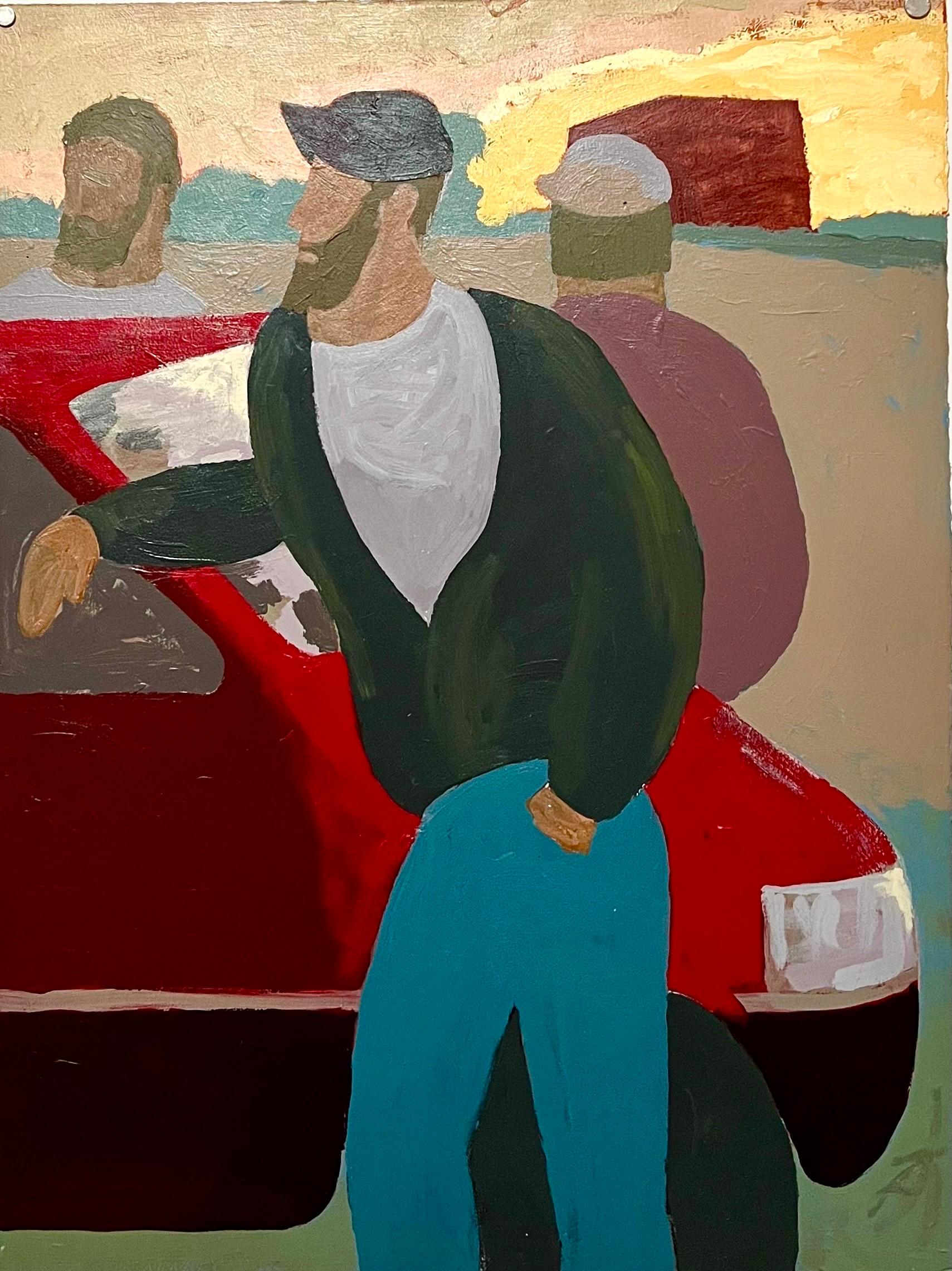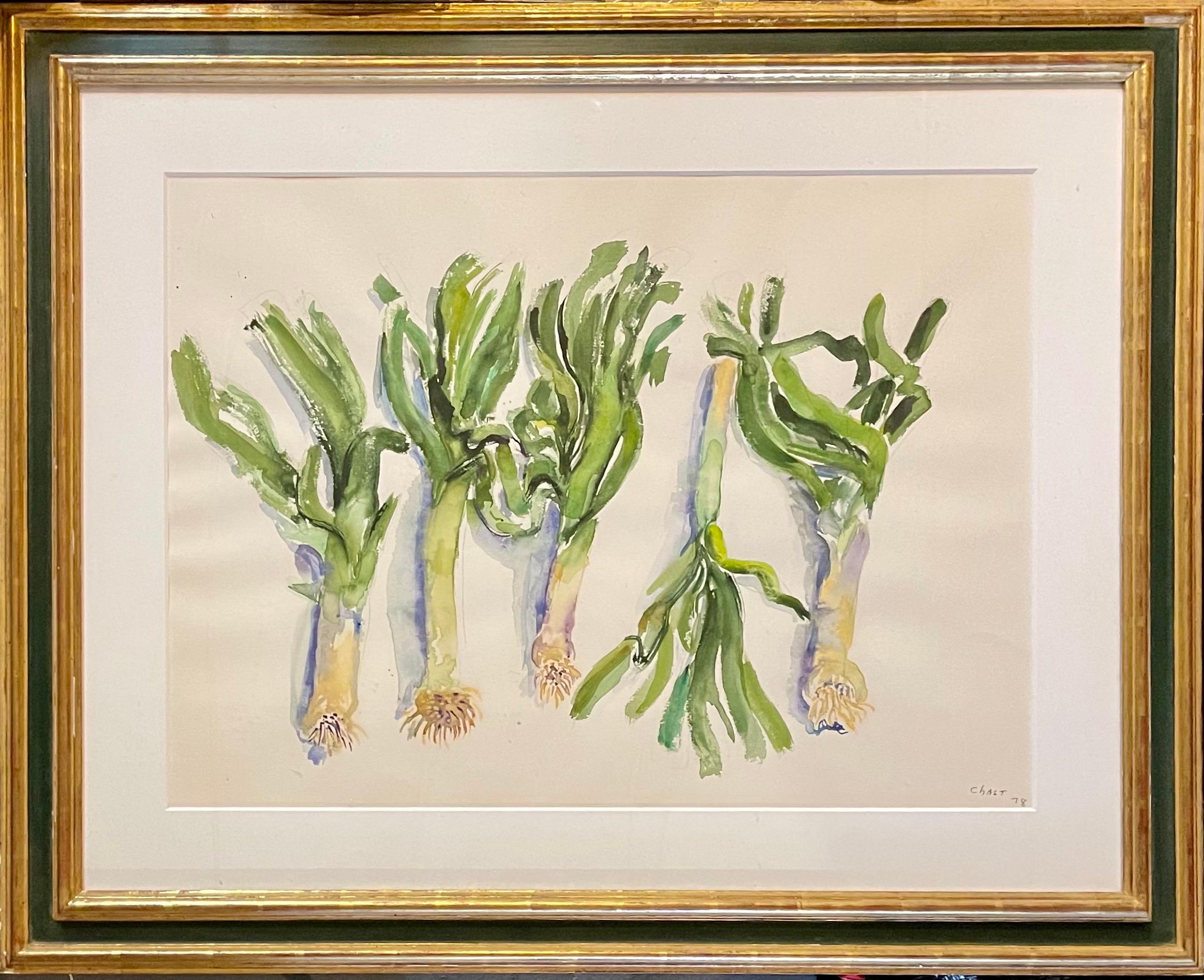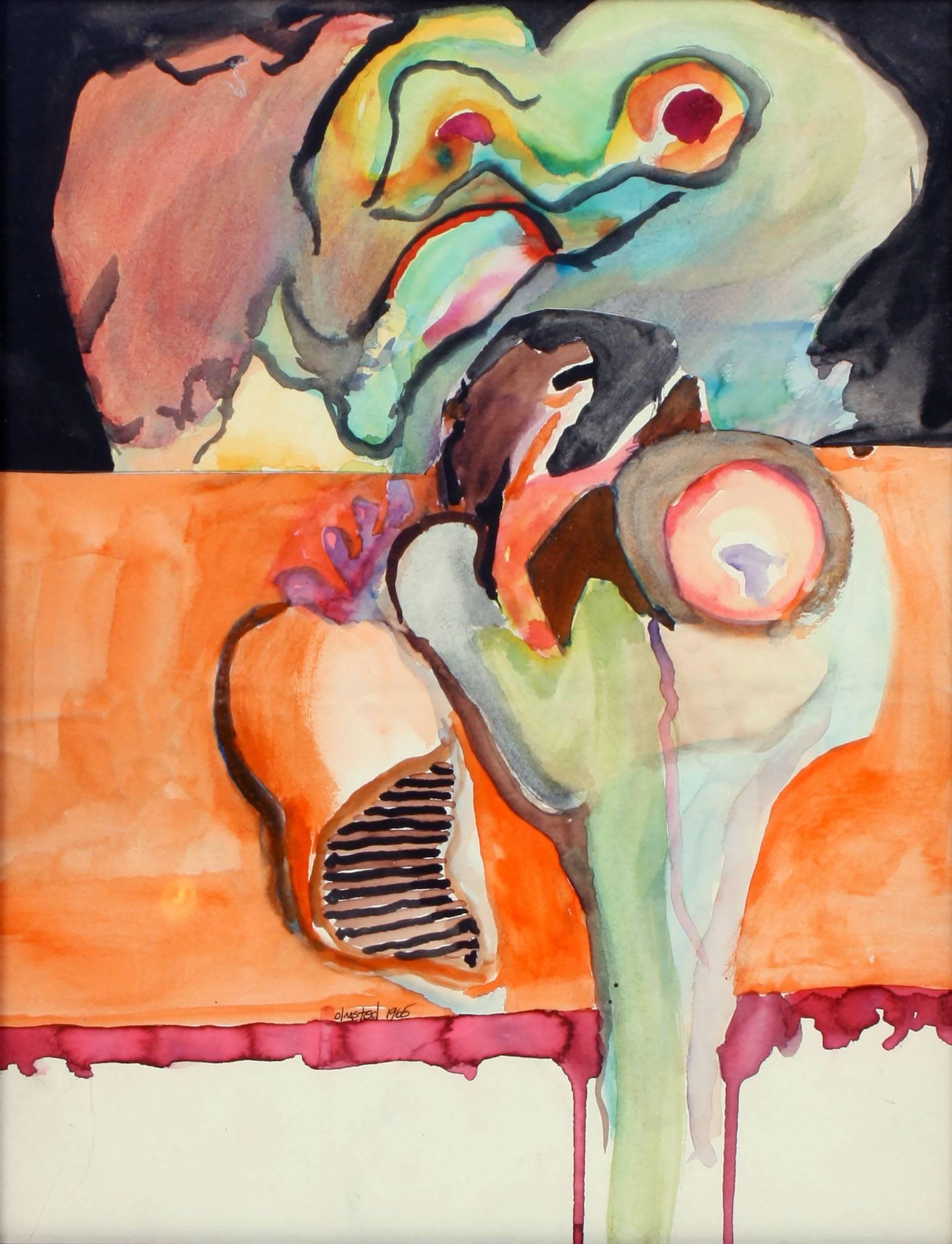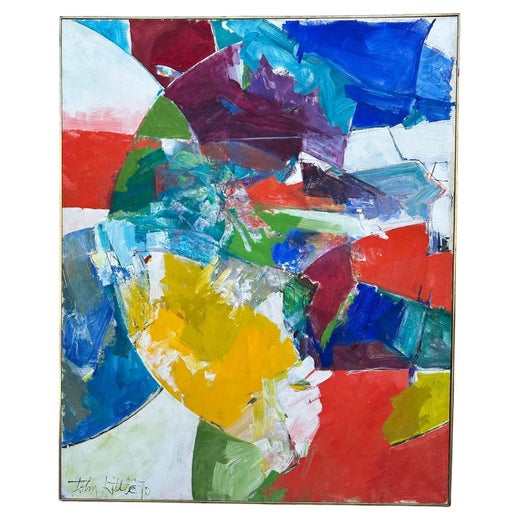Items Similar to John Little "Wallpaper Studies" Eagles, Flowers, Bunting, Color Code Bar
Want more images or videos?
Request additional images or videos from the seller
1 of 6
John LittleJohn Little "Wallpaper Studies" Eagles, Flowers, Bunting, Color Code Bar1935
1935
About the Item
SALE ONE WEEK ONLY
"Wallpaper Studies" is just that, a watercolor of a proposed design for a wallpaper with its's color code on the lower left. The painting is of a Nationalistic decorative theme with eagles, flowers, and red and white bunting all displayed on a brilliantly blue background. It might be hard to imagine now in the 21st century a room covered in such a dynamic and colorful a design, but framed as a painting, it succeeds as a bright splash of color with a reminder of important iconic Nationalistic themes.
John Little was an abstract expressionist artist who founded a New York company that made fabrics and wallpaper with designs inspired by abstract expressionism.
His work was shown in galleries in Europe, Japan and the United States. Among his larger one-man shows was an exhibition of paintings at the California Palace of the Legion of Honor in San Francisco in 1946; of paintings and collages at the Worth Ryder Gallery at the University of California at Berkeley in 1963, and a selection of his 70's works at the Fine Arts Center of SUNY at Stonybrook, N.Y., in 1981. A retrospective of his work was shown at the Guild Hall Museum in East Hampton in 1982.
John Little was born in Alabama and as a teenager attended the Buffalo Fine Arts Academy now known as the Albert Knox Art Gallery founded in 1862 and one of the oldest art galleries in the United States. Their collections are modern pieces showing styles of abstract expressionism, pop art, and art of the 1970s through the end of the century. The Knox gallery also represented such artists such as Arshile Gorky, Jackson Pollock, Clyfford Still, and Andy Warhol. Additionally, the gallery was also rich in various pieces of post-war American and European art. Their contemporary collection includes pieces by artists such as Kiki Smith, Allan Graham, Georg Baselitz, John Connell, and Per Kirkeby, the Danish painter.
Little attended the Art Student League and studied under George Grosz, painting mainly Cezannesque landscapes. From 1937 to 1942, he started working with Hans Hofmann in both New York and Provincetown, which pushed him towards abstraction and his first serious involvement as a painter. At Hofmann’s school he met artists such as Lee Krasner, George McNeil, Gerome Kamrowski, Giorgio Cavallon and Perle Fine.
In 1942 he became a naval serial photographer returning to New York after the war and moved into Hans Hofmann’s 8th Street studio where his neighbors were Lee Krasner and Jackson Pollock. The paintings of the late 1940s reveal great experimentation and a growing interest in both Surrealist automatism, Picasso and the theories of Hans Hofmann. In 1946 he had a one-man show at the California Palance of the Legion of Honor in San Francsico with a follow-up solo show at Betty Parsons. It was at this time that Little and Pollack had two main shows together that were exhibited across the U.S.
He began painting in the 1950s in thick, gestural buildup of paint and started a series of constructions created from driftwood and beach-coming detritus. Little and Pollock had a joint exhibition in 1955 at Guild Hall. He helped found the Signa Gallery, an important outpost in East Hampton for the growing New York art scene. Little had solo exhibitions at, among others, Betty Parsons Gallery, Bertha Schaefer Gallery, Worth Ryder Gallery, A.M. Sachs Gallery, and the Guild Hall Museum. His work is part of the permanent collections at The Metropolitan Museum of Art, The Guild Hall Museum, Ball State University Museum of Art and Galerie Beyeler among others.
Unframed the piece measures 32” h x 50” w.
- Creator:John Little (1907-1984, American)
- Creation Year:1935
- Dimensions:Height: 34.5 in (87.63 cm)Width: 53 in (134.62 cm)
- Medium:
- Movement & Style:
- Period:
- Condition:
- Gallery Location:Detroit, MI
- Reference Number:1stDibs: LU128616084372
John Little
Born in Alabama, John Little attended the Buffalo (NY) Fine Arts Academy as a teenager, until 1927. Soon after, he moved to New York where he began operatic vocal training and opened what would become a very successful textile business designing fabric and wallpaper. In 1933, he enrolled at the Art Students League under the tutelage of George Grosz. Little’s early work consisted predominantly of landscapes, until 1937, when he began studying under Hans Hofmann and his work naturally shifted toward abstraction. During his time with Hofmann, he with artists such as Lee Krasner, George McNeil, Gerome Kamrowski, Giorgio Cavallon, and Perle Fine. Little entered the the service in 1942 as an aerial photographer for the Navy. Returning to New York after the war and with nowhere to stay, he reconnected with Hofmann and moved into his 8th Street studio, alongside his friend Lee Krasner and her husband Jackson Pollock. In 1946, Little earned his first solo exhibition at the California Palace of the Legion of Honor in San Francisco, with a subsequent solo exhibition at Betty Parsons Gallery in New York two years later. In the early 1950s, Little abandoned the flat, linear style in favor of a new aesthetic consisting of the thick, gestural buildup of paint. This stylistic change was concurrent with his move to East Hampton In 1951. This enabled him to continue a close friendship with Krasner and Pollock, who had already left the city in favor of the more rural area around East Hampton. Little and Pollock had a joint exhibition in 1955 at Guild Hall, one year before Pollock’s tragic death. John Little exhibited extensively during his career, with solo shows at Betty Parsons Gallery (1948), Bertha Schaefer Gallery (1957, 1958), Worth Ryder Gallery (1963), A.M. Sachs Gallery (1971), and a retrospective at the Guild Hall Museum (1982). His work can be found in many private, institutional, and corporate collections around the world, including the Metropolitan Museum of Art, Guild Hall Museum, Ball State University Museum of Art, and Galerie Beyeler.
About the Seller
5.0
Vetted Seller
These experienced sellers undergo a comprehensive evaluation by our team of in-house experts.
Established in 2014
1stDibs seller since 2019
95 sales on 1stDibs
Typical response time: 4 hours
- ShippingRetrieving quote...Ships From: Detroit, MI
- Return PolicyA return for this item may be initiated within 14 days of delivery.
More From This SellerView All
- "Spiritual Self-Portrait" Watercolor, Ink, Portrait, Nude, Linear Grid, ColorsBy Artis LaneLocated in Detroit, MI"Spiritual Self-Portrait" is a portrait of the artist by the artist. She has presented herself nude gazing boldly and directly at the viewer not so much challenging, but inviting dia...Category
Late 20th Century American Modern Portrait Drawings and Watercolors
MaterialsWatercolor, Paper, Ink
- "Falling Squares" Abstract, Linear, Muted Colors, AcrylicBy William AntonowLocated in Detroit, MISALE ONE WEEK ONLY "Falling Squares" is a rich gouache painting by William Antonow. Though the colors are muted they blend in a harmony that contrasts slightly with the falling squares that bring a movement to the piece. One of the original Cass Corridor artists from the 1960s William Antonow studied at the School of the Detroit Society of Arts and Crafts (now the College for Creative Studies) and at Wayne State University, where he received his BFA (1967) and MA (1970.) Other well-known individuals who taught or studied at Wayne State University and are connected with the arts are Arthur Danto, Dr. Wayne Dyer, Susan Aaron-Taylor, Tyree Guyton, Hughie Lee-Smith, Philip Levine, Casey Kasem, Helen Thomas, Sergio DeGuisti, Stanley Rosenthal...Category
Late 20th Century American Modern Abstract Paintings
MaterialsPaper, Acrylic
- Thom O'Connor Pastel on Paper "The Model #5"By Thom O'ConnorLocated in Detroit, MI"The Model #5" is a pastel on paper showing a nude female figure emerging from what appears to be an evening darkening mist where a distant landscape is suggested or perhaps she is e...Category
Late 20th Century American Modern Figurative Paintings
MaterialsPastel, Paper
- Joyce T. Nagel Monoprint "Spring/Daffodils" Signed DatedLocated in Detroit, MI"Spring/Daffodils" captures the essence of the colors of spring and its meaning by choosing Daffodils, the first large common flower of the season that is so welcomed after a long hard mid-west winter. Flowers, also, are an iconic choice of subject matter for many artists from the Dutch Masters and their large vases of flowers to Alex Katz and his mammoth portraits of "flowers." Some of Manet's last paintings that were exquisitely rendered were of the common flowers lilacs and roses. Joyce Nagel...Category
1980s American Modern Still-life Prints
MaterialsPaper, Ink
- Kiki Smith Collage/Lithograph "squirrel" Flying Creatures Signed DatedBy Kiki SmithLocated in Detroit, MIA collage lithograph from her series Various Flying Creatures by Kiki Smith titled: "squirrel." Smith has used one of her animal/insect iconic figur...Category
1990s American Modern More Prints
MaterialsPaper, Lithograph
- Kiki Smith Collage/Lithograph Various Flying Creatures "moth" Signed DatedBy Kiki SmithLocated in Detroit, MIA collage lithograph from her series Various Flying Creatures by Kiki Smith titled: "moth." Smith has used one of her animal/insect iconic figures f...Category
1990s American Modern More Prints
MaterialsPaper, Lithograph
You May Also Like
- Large Hudson River Figurative Modernist Landscape Oil Painting Edward AvedisianBy Edward AvedisianLocated in Surfside, FLEdward Avedisian ( 1936-2007 ) Gouache or oil on paper, 3 guys around a car, hand signed in paint lower left, Measures 30"x 22.5" Edward Avedisian (June 15, 1936, Lowell, Massachusetts – August 17, 2007, Philmont, New York) was an American abstract painter who came into prominence during the 1960s. His work was initially associated with Color field painting and in the late 1960s with Lyrical Abstraction and Abstract Expressionism. He studied art at the School of the Museum of Fine Arts, Boston. By the late 1950s he moved to New York City. Between 1958 and 1963 Avedisian had six solo shows in New York. In 1958 he initially showed at the Hansa Gallery, then he had three shows at the Tibor de Nagy Gallery and in 1962 and 1963 at the Robert Elkon Gallery. He continued to show at the Robert Elkon Gallery almost every year until 1975. During the 1960s his work was broadly visible in the contemporary art world. He joined the dynamic art scene in Greenwich Village, frequenting the Cedar Tavern on Tenth Street, associating with the critic Clement Greenberg, and joining a new generation of abstract artists, such as Darby Bannard, Kenneth Noland, Jules Olitski, and Larry Poons. Avedisian was among the leading figures to emerge in the New York art world during the 1960s. An artist who mixed the hot colors of Pop Art with the cool, more analytical qualities of Color Field painting, he was instrumental in the exploration of new abstract methods to examine the primacy of optical experience. One of his paintings was appeared on the cover of Artforum, in 1969, his work was included in the 1965 Op Art The Responsive Eye exhibition at the Museum of Modern Art and in four annuals at the Whitney Museum of American Art. His paintings were widely sought after by collectors and acquired by major museums in New York and elsewhere. He has been exhibited in prominent galleries, such as the Anita Shapolsky Gallery and the Berry Campbell Gallery in New York City. Edward Avedisian was known for his brightly colored, boldly composed canvases that combined Minimalism's rigor, Pop art exuberance and the saturated tones of Color Field painting. Roberta Smith of the NYT writes of Avedesian: "Edward Avedisian helped establish the hotly colored, but emotionally cool, abstract painting that succeeded Abstract Expressionism in the early 1960s. This young luminary harnessed elements of minimalism, pop, and color field painting to create prominent works of epic proportions that energized the New York art scene of the time." In 1996 Avedisian showed his paintings from the 1960s at the Mitchell Algus Gallery, then in SoHo. His last show, dominated by recent landscapes, was in 2003 at the Algus gallery, now in Chelsea. Selected Exhibitions: Op Art: The Responsive Eye, at the Museum of Modern Art, Whitney Museum’s Young America 1965 Expo 67, held in Montreal, Canada. Six Painters (along with Darby Bannard, Dan Christensen, Ron Davis...Category
20th Century American Modern Landscape Paintings
MaterialsOil, Gouache, Archival Paper
- Large American Modernist Watercolor Painting Leeks Bernard Chaet ExpressionistBy Bernard ChaetLocated in Surfside, FLHand signed and dated leeks on a kitchen table 31.5 X 39.5 framed. 21 X 28.5 sheet without frame. Bernard Chaet (born 1924, Boston, MA - 2012) was an American artist; Chaet is known for his colorful, dynamic modernist paintings and masterful draftsmanship, his association with the Boston Expressionists, and his 40-year career as a Professor of Painting at Yale University. His works also include watercolors and prints. In 1994, he was named a National Academician by the National Academy of Design. Chaet was instrumental in transforming Yale’s traditional art program into one with a more modernist approach that gained national prominence. Chaet melded landscape and abstraction in a traditional established by Vincent Van Gogh, Georges Seurat, Edvard Munch, Piet Mondrian, and Ferdinand Hodler. His own tenure began in 1951 at Yale, where he worked closely with Josef Albers to revamp Yale’s art program. Between 1959 and 1962 he was the chair of what was then called the Yale Department of Art of the School of Fine Arts — prior to becoming one of the independent professional schools at Yale in 1973. Chaet taught painting and drawing and mentored generations of emerging talents. Chaet was the author of the 1970 textbook “The Art of Drawing” and “An Artist’s Notebook 1979,” both of which have since been reissued several times. In the latter book, alongside examples of work by his favorite artists, are student drawings by Yale graduates such as Robert Birmelin, Michael Mazur and Eugene Baguskas. Born in Boston, Massachusetts, in 1924, Chaet studied at the School of the Museum of Fine Arts in Boston and then earned a B.A. at Tufts University. Known for his expressionist landscapes and still lifes, Chaet’s work has continuously been shown in galleries in his native Boston, in New York City, and around the country. In 2010, a retrospective of his seascapes was featured at the Cape Ann Historical Society in Gloucester, Massachusetts, where he had a home and a summer studio in nearby Rockport. His has also exhibited at David Findlay Gallery in New York and at Swarthmore College. Many of Chaet’s students went on to notable art careers, including Janet Fish, Chuck Close, and Richard Serra. His work is represented in the collections of the Brooklyn Museum, the Art Institute of Chicago, the Metropolitan Museum of Art in New York, the DeCordova Sculpture Park and Museum in Lincoln, Massachusetts, the Hirshhorn Museum and Sculpture Garden in Washington, D.C., the Museum of Fine Arts in Boston, the Yale University Art Gallery in New Haven, CT, and the Addison Gallery of American Art in Andover, MA. Chaet is the recipient of many awards including: the National Foundation of the Arts and Humanities, Sabbatical Grant in 1967-68, the National Academy of Fine Arts, Benjamin Altman Award in Painting in 1997, and the American Academy of Arts and Letters Jimmy Ernst Prize in 2001. Chaet was born and raised in the Dorchester neighborhood of Boston, MA. He completed a dual program at the Museum of Fine Arts, Boston—studying painting with Karl Zerbe—and Tufts University, graduating with a B.S. in 1949. Chaet is known for his association as a first generation Boston Expressionist. (along with Hyman Bloom and Jack Levine) Chaet was a contributing editor to Arts Magazine. In 1960 he published the book Artists At Work, which features in depths conversations with artists Pat Adams, Anni Albers, Josef Albers, Al Blaustein, Hyman Bloom, James Brooks, Robert Engman, Esther Geller, Seymour Lipton, Conrad Marca-Relli, Gabor Peterdi, Irwin Rubin, Elbert Weinberg...Category
1970s American Modern Still-life Paintings
MaterialsWatercolor, Gouache, Archival Paper
- Abstract LandscapeBy Wes OlmstedLocated in Buffalo, NYAn original watercolor painting by American artist Wes Olmsted depicting an abstract landscape view.Category
1960s American Modern Abstract Paintings
MaterialsArchival Paper, Watercolor
- Abstract Work on Paper Mid-Century Modernism Greek American Gouache DrawingBy Jean XceronLocated in New York, NYAbstract Work on Paper Mid-Century Modernism Greek American Gouache Drawing. A modernist artist who emigrated to America from Greece in 1904, when he was fourteen years old, Jean Xceron is described as having a reputation as an artist that has mysteriously fallen into obscurity---especially since he was reportedly quite prominent during his lifetime. However, a partial explanation of that omission is the fact that many of his papers and early records have been lost. He was a painter of biomorphic abstractions and did collages, which were influenced by Dadaism. Xceron was active in New York City when modernism was gaining influence. Of him during this period, it was written that his artistic role was "a vital link between what is commonly termed as the first-generation (the Stieglitz group, the Synchromists, etc.) and second-generation, the American Abstract Artists, the Transcendental Painting...Category
1940s American Modern Abstract Drawings and Watercolors
MaterialsPaper, Gouache
- Suzanna and the EldersBy Ben ShahnLocated in Miami, FLA modern interpretation of the biblical story Suzanna and the Elders. Signed lower right Ink and wash on paper The Downtown Gallery Felix Landau Gallery Ernest Brown & Phillips, Ltd...Category
1940s American Modern Portrait Paintings
MaterialsWatercolor, Ink, Gouache, Archival Paper
- Untitled [Abstraction]By George L.K. MorrisLocated in New York, NYGouache on paper, 18 7/8 x 14 3/4 in. Signed (at lower right): Morris; (with monogram, on the back): GLKM [monogram] / 1932 [sic] Executed circa late 1940s A passionate advocate of abstract art during the 1930s and 1940s, George L. K. Morris was active as a painter, sculptor, editor, and critic. An erudite man with an internationalist point of view, Morris eschewed the social, political, and figural concerns that preoccupied so many artists of Depression-era America, believing that painters should focus their attention on the beauty, refinement, and simplicity of pure form instead. His goal, he said, was “to wedge the expression further and further into the confines of the canvas until every shape takes on a spatial meaning” (as quoted in Ward Jackson, “George L. K. Morris: Forty Years of Abstract Art,” Art Journal 32 [Winter 1972–73], p. 150). Born into an affluent family in New York City, Morris was a descendent of General Lewis Morris, a signer of the Declaration of Independence. From 1918 until 1924, he attended the Groton School in Connecticut, studying classics and art. He continued to focus on literature and art while attending Yale University (1924–28), an experience that prepared him well for his future activity as an artist-critic. After graduating in 1928, Morris studied at the Art Students League of New York, working under the realist painters John Sloan and Kenneth Hayes Miller, as well as Jan Matulka, the only modernist on the faculty. In the spring of 1929, Morris traveled to Paris with Albert E. Gallatin, a family friend and fellow painter who introduced him to leading members of the Parisian avant-garde, including Jean Arp, Pablo Picasso, Georges Braque, Jean Hélion, and Piet Mondrian. Morris also took classes at the Académie Moderne, studying under Fernand Léger and Amédée Ozenfant, important exponents of Synthetic Cubism who influenced his aesthetic development. Indeed, after experimenting with the simplified forms of Modernism for a few years, Morris moved on to abstraction by 1934, adopting a hard-edged, geometric approach inspired by Leger’s cubist style and the biomorphic shapes of Arp and Joan Miró. Following his return to New York in 1930, Morris built a white-walled, open-spaced studio (inspired by that of Ozenfant, which had been designed by Le Corbusier) on the grounds of Brockhurst, his parents’ 46-acre estate in Lenox, Massachusetts. In 1935, he married the painter and collagist Estelle “Suzy...Category
1940s American Modern Abstract Paintings
MaterialsPaper, Gouache




![Untitled [Abstraction]](https://a.1stdibscdn.com/george-lk-morris-1905-1975-american-paintings-untitled-abstraction-for-sale/a_23/1652214284908/APG_8941_unfr_master.jpg)
